2019 is a meager year when it comes to big living history events in Denmark but here is my watch list for this year.



2019 is a meager year when it comes to big living history events in Denmark but here is my watch list for this year.

Historiske Dage / Days of History is a Danish non-profit event taking place in Copenhagen every year. It has run for 4 consecutive years and is one of the biggest history events in Denmark. I was there with a display by the Copenhagen Historical Fencing Club (KHFK). In this post I will comment on Historiske Dage and historical fencing.

This past weekend (June 17-18) Oplevelsescenter Vestvolden (Experience Centre Western Ramparts) hosted an amazing event, “The War History Festival”. I believe it is the first of its kind in Denmark. it took place over Saturday and half of Sunday, it is a pity it is not any longer but it is cut short Sunday to allow the organisers to strike camp and head home as most are volunteers. The setting is very unique, it is a museum which is built into the old fortifications that protected Copenhagen. These were built during the late 19th century.
The festival itself took place along a 1.2 km path which runs along the bunkers. it consisted of a number of reenactment camps from groups all over Denmark. it was all free and the volunteers did an amazing job. The camps were laid out in chronological order, starting with Roman soldiers and ending with Soviet special forces. Every camp has a year assigned to it, I was there with the historical fencing club representing 1570.
I have been in contact with a few reenactment groups in Denmark but I had no idea that reenactment was this big. There was everything from Roman legionaries, vikings, historical fencing, 1807 (Napoleonic Wars), 1864 Schleswig War and American Civil War, WWI Germans and WWII both British and Germans represented as well as 1962 Soviets with plenty of vehicles.
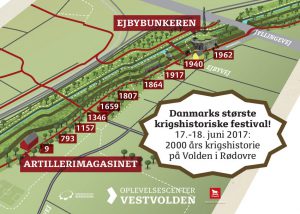
Early draft, as more and more reenactment groups joined, camps were added or removed
Can You Celebrate War?
A festival over war history seems like such a contradiction. How can we celebrate the killing of others? It could easily sound like a way to romanticize or glorify war but I believe it is quite on the contrary. For us to understand history we need to get into the mind of people who lived in those times because otherwise we shall never be able to understand it. If we only apply our modern thinking and ethics, we will naturally simplify and draw wrong conclusions. To understand how slavery could exist for thousands of years as an institution, we need to understand how people in those times thought, not simply brush it off as but we have gotten smarter, more modern etc.
I therefore believe that a gathering of reenactment groups like this is an important way of getting people a little bit closer to what life would have been like. Reenactment I feel is still very small in Denmark although growing. It is important not to confuse it with role-playing. While role playing is about dressing up and sometimes in historical periods, the role playing is more about creating a story with villains and heroes. Reenactment is about living history. It is the recreation of a life style and mind-set through trying to feel in on your own body. In history books we are often only concerned with the broad lines, the generals and the big battles, but forget the ordinary soldier.
Reenactment for me is the rediscovery of history. It allows us to feel and understand the daily life of ordinary people. Most reenactment concentrates on war I personally believe it is because often we humans are drawn towards the conflict, the tearing of societies and the drama, because of the contrasts and questions that those pose to us, how would we have reacted, what was it like?
So I do not feel we try to celebrate war itself, rather, we try to understand strength and horror of the people who lived in trying times.
Reenactors in Denmark
One of the things I liked about the festival was the big turnout of reenactor groups. many of these I did not even know existed. I only managed to talk to a few of the reenactors and as a presenter myself, I unfortunately did not have a chance to talk to that many other but i wanted to highlight a few.
For American Civil War “Blue and Gray” put on a very good fight show on Sunday. I believe the roar of cannons were something that really shook the audience. The spectacle of deafening noise and nauseating smell of powder is something that cannot be understood from movies. This is where I truly feel reenactment comes into its true potential. Blue and Gray is particularly interesting because they try to portray companies which had large contingents of Scandinavian immigrants so although we are far from the battlefields of 1860s USA there is still a connection to Denmark.
“Regimentet” is a group that portrays the ordinary occupation troops in Denmark during WWII and were represented under 1940 (the year of the invasion). The dedication to details of these reenactors is amazing. I have thought to join them more than once.
Other WWII groups were “WWII Tommies” portraying British troops under WWII and “Danforce”. “Danforce” deserves a lot of attention as they represent a unit that many people may not even have heard about. During WWII a Danish force was formed in neutral Sweden and stood ready to enter back into Denmark. This force certainly deserves a blog post here at a later stage being almost forgotten.
“Westfront 1916” is a WWI reenactment group, I did not managed to get to speak with them but I think it is very interesting, specially because Denmark was not part of WWI.
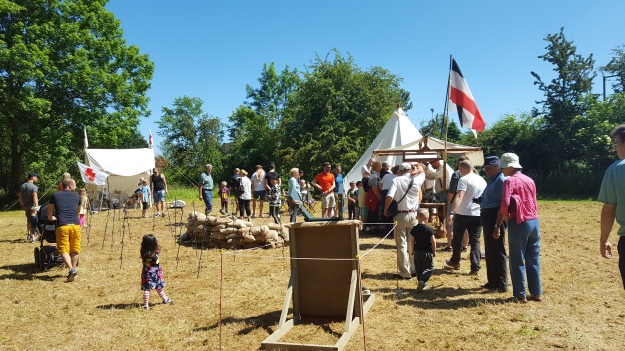
The German WWI camp with field hospital
1570
Copenhagen Historical Fencing Club (KHFK) was present at the festival under the year 1570. Now that year was not chosen for any particular event or war but rather by a book: “Art of Combat” by Joachim Meier. He was a German fencing master and in that year published a very comprehensive book on a number of different weapons such as longsword and early rapier among others.
It is a real honour to be invited to the event as I feel we are slightly off as we are not reenactors as such. KHFK practices HEMA (Historical European Martial Arts) which is an umbrella term for recreating European fighting based on old manuscripts (which is where Meier is so important). Many of the manuals do however not focus on war, rather they focus on the duel or self-defence is being attacked in a more day-to-day life setting. This means that the person defending himself typically only have what he would practically and comfortable be carrying. So that means no armour, as a normal person would likely not go shopping wearing an armour and also it means weapons have to be easy to carry, typically what could be carried hanging from a belt (that keeps both hands free for all the regular daily stuff). A good example is the shield, while it was recognised that a shield was very useful, a big shield, simply was not practical and would likely have to be carried on the back, meaning it was slow to get out and its was a burden to carry for the odd chance of getting robbed. Bucklers are much smaller shields which can be carried suspended from a belt (see below for pictures).
Fighting an armoured opponent is a different game and generally not covered in our ways of training as it is very difficult to simulate in full contact sparring. To defeat armour one has to stab at the openings where the armour does not protect and that is inherently very dangerous and no safe way of doing that has yet been found.
For our stand it consisted of two parts; a weapon display over which we could talk and a fighting area, where we would show off sparring. While the weather was lovely for an outdoor event, I also thought it killed off a bit of enthusiasm for fighting in a thick fencing jacket as it gets really warm. With longsword and sword and buckler (small round shield) generally being the most popular in the fencing club and no other rapier fencers, I decided to rather show and tell than fight.
Fencing in the Spot Light
For me as a participant I love to show off simple ideas and treat misunderstandings. While I would love to get more advanced I also know that it is likely too difficult to grasp as many people would not have held a steel blade before.
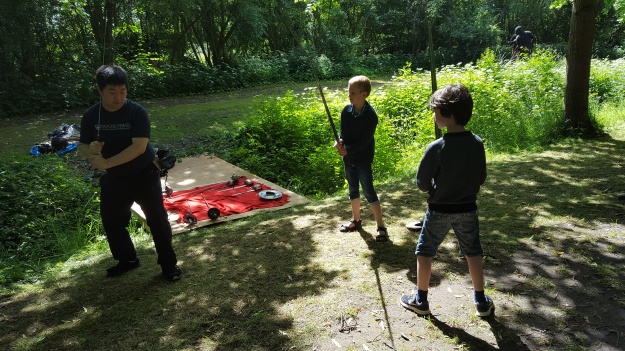
Learning to handle the sword and do foot work
I managed to teach a bit of basic stance and foot work, that can be taught in short 5 minute lessons which is about the attention span of a 5 year old when there are so many other things going on. I find that only the most basic stuff does well if attempting to teach.
There is a lot of footwork and stance involved in fencing, so it actually a good place to start. The feet are typically placed at a 90 degree angle, so I can move back and forth without stumbling over my own feet, also if I need to move in a hurry. I like to bend in the knees to get a good stable position to fight from. If fighting with weapons that only has a simple cross guard such as the “two-handed” longsword or medieval arming swords, the sword hand is generally held back unless attacking or defending. With weapons with more complex hand protection weapons are usually held out in front of me for reach. I believe such things are easy to grasp and convey and serves as great appetizers if people are interested.
While we gathered a good crowd over the whole day, I think the biggest exciment for people was to be allowed to hold the weapons. Swords to most people are surprisingly light although wielding them often seems a bit of exercise, that is because most modern people to not use their underarms very much any more but those are actually some of the muscles used most for swinging. Weapons themselves are around 1 kg for one-handed swords (some a bit lighter and some a bit heavier), humans around the world and across history may have varied in size but that seems a good weight. Longswords are used mostly in two hands and weigh around 1.5 kg.
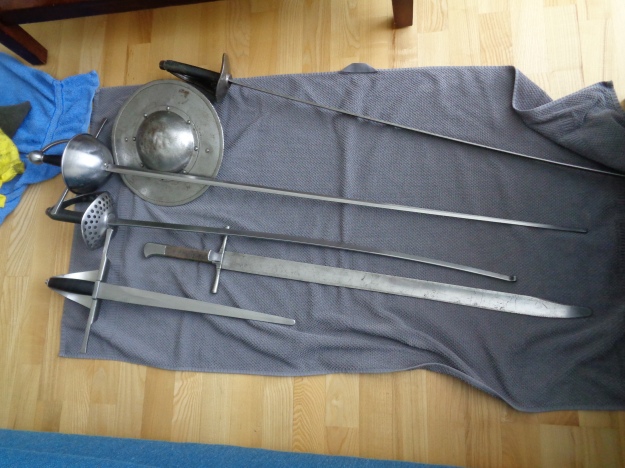
A bit of weapon maintenance after the show. All these weapons are one handed weapons at a weight of around 1 kg. Note the small shield known as a buckler
Links at the bottom for more on HEMA.
Special Thanks
Thank to Oplevelsescenter Vestvolden for hosting the event. I am looking forward to next year (the dates will be June 16-17). I really hope this will be a yearly event going forward. It was great fun presenting and great to see so many other people being so passionate about reenactment.
Some suggestions for next year, it would be better if the audience was guided more into the camps either by a presenter or sign posts. While the path is lush, green and beautiful, it is flanked by ditches which makes a natural barrier to the audience and people are reluctant to cross. I would like to invite the audience more into the camps for more interaction. For the battle recreations, better speaker systems around the whole battle area would be great, it is some very good presentations but hard to hear over the noise of battles. Also perhaps try to give key reenactors a microphone such as commanders, I know it does not look great but it would help the audience understand.
See you next year!
Links:
For more on Oplevelsescenter Vestvolden see:
For more information about Copenhagen Historical Fencing Club, visit the club at http://www.KHFK.dk
A lot more information on HEMA can be found on my previous blog posts:

I love teaching when I can get to talk about the things I love. This is in large parts also why I started this blog, to pass on the things I have learned and the share the passion that hopefully could get others to enjoy the things that I do. Copenhagen Medieval Market, which is currently on, is one of those chances I get to talk to a bigger audience; after all I am an engineer so getting to talk about history is a bit rare.
Copenhagen Medieval Market
The market ran from June 2 to June 5 and is attended by all kind of people with some interest in medieval (or medievalesque fantasy). I have a bit of mixed feelings towards that but I also know that children love swords and gather much of their inspiration from fantasy and the market is bringing roleplaying orcs and elves because children love them, so to be able to gather enough people, so a more lenient approach must be applied. Anyway that way I felt I could bring out my rapier even though out of period (as I do not specialize in long sword or sword and buckler which were the main highlights of the show).

I have slowly gotten myself more involved in HEMA. Back in April I slowly started up with rapier and dagger. I am learning really slowly and I can truly feel I the last 10 years have not done much sport and I can really feel how I suffer from the lack of body awareness and general fitness and thus my learning suffer as I find it hard to get the small details in the stances correct. But it is a good way of getting some exercise and also meet new people and having fun with reconnecting with history, so that is some of the things that keeps me going.
Competitions have never been a big thing for me, I am not very competitive (although believe me I hate losing) but winning is not what it is about to me. I have been thinking all along that I was disadvantaged being short and suffering from a knee injury which resulted in surgery but never have gotten fully functional, so I tend to have difficulties getting a good stable stance with bent knees. The first HEMA event I got into contact with was Copenhagen Open which is part of the NHFL (Nordic Historical Fencing League). NHFL include tournaments in rapier and dagger and longsword but most local tournaments also include sabre. I went and watched the sabre and rapier and dagger in Copenhagen Open in 2016 and I really felt that I did not have the level to compete.
But Swordfish is very different in the sense that it is not only a tournament, it is about getting together and enjoying a mutually shared hobby of having a go at European martial arts. While there is a lot of tournaments, it is just as much about workshops for learning and sharing knowledge about the studies of historical manuals. I think that is a very important part of HEMA, the deciphering of manuals and converting them into actual techniques. Unlike many of the Eastern martial arts where the practices have been handed down from master to student in an unbroken line, most of the HEMA disciplines have had clear breaks in practices. An exacmple is the still ongoing discussion about how to hold a viking sword. There are many hypothesises out there but it is only to trying to apply them that we can truly figure out what makes sense.
The Swordfish Event
The Swordfish event this year was the 11th annual version and took place November 4-6 2016. It takes place in Mölndal in Sweden just outside of Gothenburg. It takes place in a bowling and sports complex known as “Aktiviteten” and comprises of two sports halls which are split in two and a number of smaller halls including a taekwondo and ping pong halls (used only for sleeping) for a total of 5 different rooms with activities. The day is split into 3 parts, morning, afternoon and evening of four hours divided by times to go for breaks or meals. In each section runs either tournament games or workshops (of 2 or 4 hours in length). One hall is reserved for sparring. There is also a small resting area with a cafe that serves drinks and snacks. Only breakfast and the dinner before the tournament is provided, the rest of the meals will usually be by going into Mölndal and find some food. I was happy enough with going to the supermarket and buy some bread and a salad.
it is possible to sleep at Aktiviteten which most people do. Sleeping is in some reserved halls and people cannot be too picky. If that is not for you, it is possible to get hotels in the town as wll. For me personally I thought sleeping in a hall with 40 other people would be a problem but people are really disciplined with noise and very friendly so it was never a real problem.
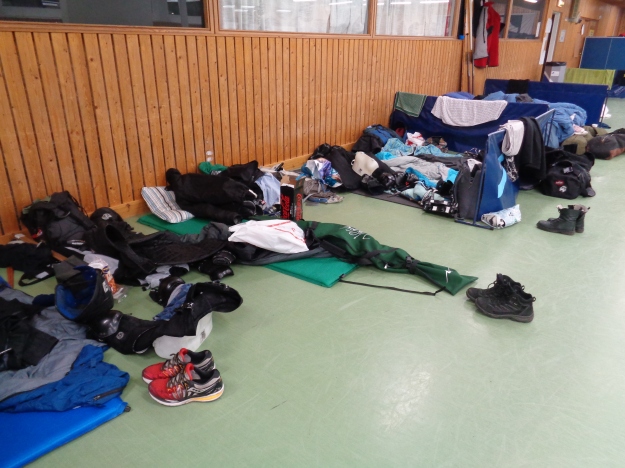
The Copenhagen Corner
Swordfish Workshops
There were more than 20 workshops this year covering a wide range of weapons as well as wrestling and general body awareness and ways to overcome combat stress.
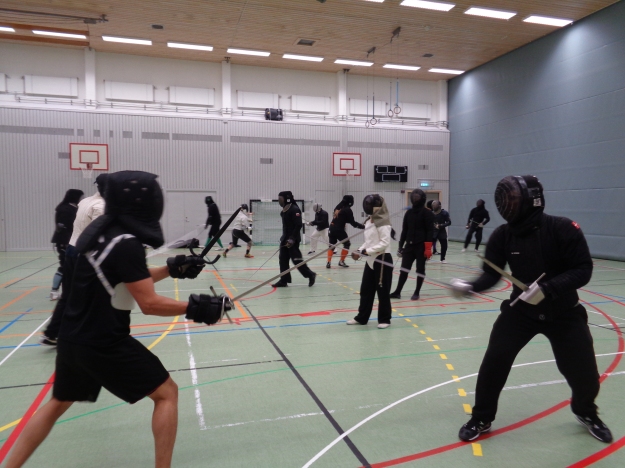
From Francesco Loda’s Roman Rapier and Dagger Workshop
One of the greatest take aways for me is: what most people are unaware up is that while you can practice techniques all you want and it will look nice and good, once you step into a match even if just a training match a lot of this goes out the window. It is often in the human nature that after just a half a minute of so the body gets tired, stances get a little more lazy and people tend to subconsciously try to end the matches quickly because it is tiring which led to a lot of risky attacks. If I can hold my stance just a little longer than my opponent I can often get him to make mistakes.Once tired most people will tend to push forward to try to end the match thus we learned to make different techniques to recognise when the opponent is coming forward to apply deliberate pressure to make me make a mistakes or when he want to seize initiative to end the match and how to shut them down. That is why technique and strategy is important but also the body awareness to not freeze in such situations and be able to execute the techniques under pressure and not fall for lazy methods.
Sparring
One of the great advantages of a huge gathering like Swordfish is the number of people willing to do sparring and who come from clubs that train different techniques. My sabre techniques were taken completely apart during the sparring and my rapier techniques definately need some work although the recent change from the fencing treatises of Capoferro to Fabris did help me as it was a bit of a surprise to some.
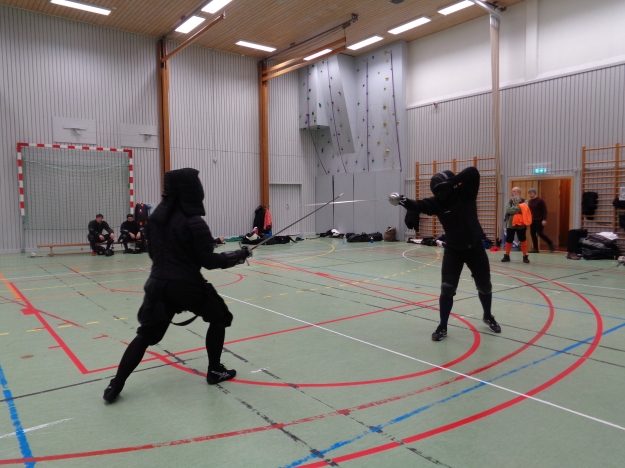
Sparring with different Italian style rapier stances. Fabris inspired styles
Sparring for me is the thing about HEMA I love the love, I am still at a level were when I step up to spar my techniques go right out the window
Tournaments
Some call Swordfish the unofficial world championship for HEMA and while the event has been a lot more international than I thought and the organisation more professional, I still think HEMA has some way to go to become a developed and accepted sport.
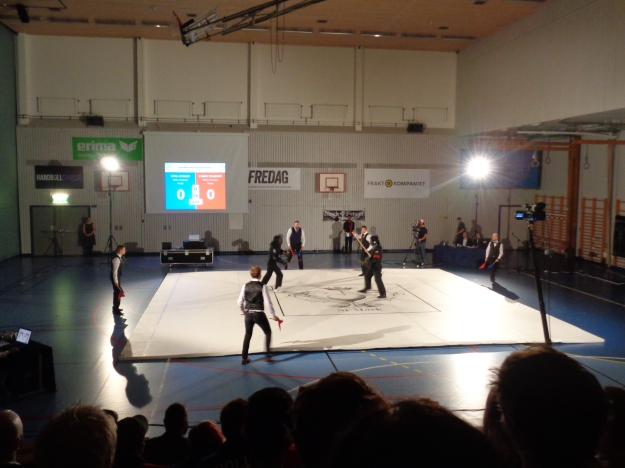
A typical match setup. Here military sabre
The way matches work is that they in the finals take place over 2 rounds of 3 minutes. The judge in the middle ensures that the fencers are behaving and separates them after hits are scored. The four line judges carries two flags, one red and one blue, and use these to indicate points after each exchange. Points can be awarded for head and torso hits for instance 2 points and rest 1 point indicated by raising the flag above the head or at a straight arm. There is in each exchange quite a lot of time for afterblows or hitting back after having suffered a hit and that could potentially nulify the hit you just took. This is done to ensure a historical fencing style and to avoid suicidal moves that would with sharp weapons get you killed in the return. Unlike movies people generally do not drop dead instantly after being hit thus the afterblow rule is important and would have been for fencers in past times as well. Wrestling matches are only one round of 3 minutes.
At 2 minutes 50 seconds of each round “last exchange” will be called and the fencers will be allowed to complete the exchange no matter how long time it takes. In case of even score sudden death is applied after the 2 rounds.
I strongly recommend anyone with an interest to take a view at the live stream broadcasted of the finals at: http://www.rpmedia.se/2016/10/11/swordfish-2016/
For me the commentators really helped with understanding weapon types I do not normally use.
Enjoy and hope to see you at Swordfish next year.

I was quite late to using YouTube for other purposes than the odd silly video or for music playlists but there are actually quite a lot of good quality infotainment or documentaries out there. The main problem is where to find it and there is really too much stuff out here which is poorly sorted. It took me quite a while to get it going but with the way that YouTube remembers what I have seen last and come up with suggestion, I have now got a critical mass to really find some of the great stuff. So I thought if you read my blog you probably have similar interests so I will help you by sharing some of the channels I have found interesting.
I would therefore in this post talk a bit about my favourite YouTube channels.
Scholagladiatoria
Topics: HEMA, weapons, armour
There are a few HEMA channels out here, some of them seems quite good but as I got into historical martial arts very late and only have been doing it for short a while, I still do not have a lot of use of instructional video lessons yet. However Matt Easton of Scholagladiatoria is actually the one who got me into HEMA in the first place. I started with his videos on weapons but as Matt is a HEMA sabre instructor and he talks a lot about HEMA and weapons used in a historical context and antiques, so I slowly progressed into HEMA videos. I find him very knowledgable and his specials about armour, LARP and other topics. If you are interested minute details about different weapons and HEMA this is a must.
History Buffs
Topics: General history, Movie Reviews
Nick Hodges has a very interesting if somewhat different channel. he reviews historical movies from a historical perspective commenting on accuracy, authenticity and style. Videos are a bit long, around 20 minutes, but well worth it. The channel is a bit slow and Nick only releases about one review per month and is currently breaking for the summer, this is a very well researched and well worth the wait.
I think the show has lost a bit of its edge over time and Nick is not really getting into the flesh of historical inaccuracies but maybe that is just something temporary or because the latest couple of movie views have been on much more well known topics with more sources and this need to cover way more stuff than what can be squeezed into a 20 minutes review.
Historia Civilis
Topics: Rome, Ancient History, Battle Strategies
It may not be the most flashy or appealing YouTube channel at first glance but Historia Civilis is one of the very best out there for information about ancient Roman society. It has a simply visual style but is very informative and in depth and covers difficult topics such as the political systems of Rome in a way that few have been able to explain with such easy before. It also covers warfare and battles which instantly makes it a favourite of mine although my main interest normally starts with late medieval and to modern day warfare.
The Great War
Topics: World War I
The Great War project really deserves mentioning for being a very different themed channel. Indiana (Indy) Neidell talks about WWI but in way more details than most. It is a project that has run for 2 years now and covers the war week by week in a 10 minute video exactly 100 years later, so not only is the war presented in this weeks event 100 years ago in good details, a number of supporting videos with extra background information has also been done. Take a look at it and try to catch up, it is well worth it.
Forgotten Weapons
Topics: Firearms, technical details, Military History
This channel is very interesting at least for a European as I am not very used to firearms neither being around them nor firing them. Ian from Forgotten Weapons has a very nicely presented channel in collaboration with Rock Island Auction House which allows him to take a look at a number of speical guns that go up for sale at the auction. So if you are interested in all kind of firearms that you probably have never even heard about, head over an take a look. Perhaps even cooler than digging out forgotten weapons is that Ian takes many of the weapons apart so you can see the intriquet workings of each time and explain how they work. I have learned a lot about small differences and details. Great channel for gun enthusiasts and engineers.
I had originally decided only to select top five but I do think there are a couple that deserves “mentioning in dispatches”.
Lindybeige
If you are looking for a good ramble about history, philosophy or sciences take a look at Lloyd’s channel. Llyod likes to take up all kind of stuff that he comes across much like blog and for that I really like it. Some of it may challenge opinnions and possibly annoy people but I like getting challenged to think.
Metatron
Italian orientalist with a keen interest on both Japanese and European martial arts as well as ancient Rome, this channel mixes it all other with fancy costumes and replicate armour. The channel has changed a lot back and forth but I think there is something to cater for most people interested in martial arts or history.
Shadiversity
Oh boy, that guy can talk and go on and on and on for hours, medieval themed in most of its videos, it also talk about a lot of practical aspects of weapons, architecture and mixing it all up with a bit of roleplaying and computer game comparisons. Check it out, good stuff.
Finally since I am very interested in HEMA, I highly recommend Cedric Hauteville’s crowd-funded documentary about the art which can be found for free on YouTube:

Over the last couple of months I have gotten myself heavily involved into historical fencing by attending lessons at Københavns Historiske Fægteklub (Copenhagen Historical Fencing Club).
I started out with rapier and dagger but I have also moved into sabre and given long sword a try (although I am not yet convinced I like the style). I am very happy to have gotten into historical fencing which quickly got me hooked much more than sport fencing ever did when I tried it out when I was younger.
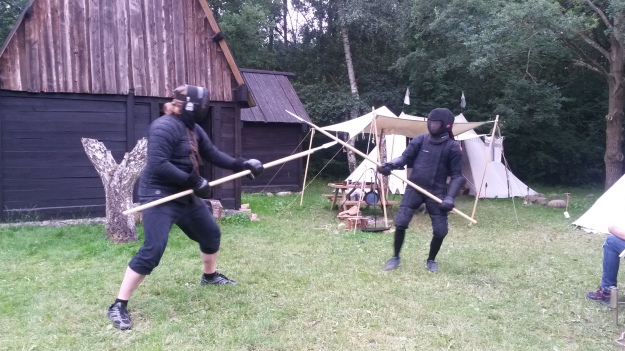
A HEMA Spear Seminar hosted by the reenactment group Korsfarerne (The Crusaders) in Denmark
Historical Fencing or HEMA
Historical fencing is much more than bashing each other with replicas of historical weapons, so to help define it, we first need to talk about HEMA (Historical European Martial Arts). HEMA is to a large extent the recreation and relearning of historical techniques for fighting and as such also include use of wrestling and firearms but generally means weapon fighting with sabre, rapier, long sword, sword and buckler but other weapons also make their way into the game. This is done primarily to simulate unarmoured combat (the armoured combat disciplines are something completely different which I will come back to later in a later post). There are quite a few other HEMA like types such as Kenjutsi (which look into Japanese sword traditions) but for all of them it is the use of old manuals and manuscripts combined with experimentation that form the basis. There are especially in Europe a number of traditions handed down in preserved texts such as Talhoffer or Fiore, see for instance:
https://www.youtube.com/watch?v=4GoQlvc_H3s from about 2 minutes into the video or https://www.facebook.com/angryrussiangunsmith/videos/1567783920184437/ for a trimmed down version.
Other masters which I at least have partially studied is Capo Ferro for rapier and dagger but there are many more out there which can be studied.
While it for me at least is mainly about recreating history, it too can be competitive and there are a number of tournaments world wide but HEMA while growing is still very niche compared to sport fencing.
Historical Fencing versus Sport Fencing
So what is so different from historical fencing and sport fencing?
I feel that historical fencing is much closer to what fencing would really have been like, it is not to belittle sport fencing because I do believe sport fencing is a great sport but from a historical point of view I do have serveral issues with it.
I do understand that everytime a game has rules people are willing to exploit the rules to the limit in order to gain an advantage or ultimately for winning and the same goes for both HEMA and sport fencing. While rules in HEMA still a very flexible due to the young nature of the sport, sport fencing has unified and rigid rules. So when something in the eyes of some HEMA tournament organisers are found to work poorly they generally try change the rules of their tournament such as reducing the number of hits to hands if people are targeting these consistently etc. to make the fencing look more like what fencing should. But for sport fencing because of the unified nature rule changes are different and it feels like over the last 100 years when fencing got to be an olympic sport that fencing in historical context and sport fencing have deviated so much from each other due to rules that sport fencing to me no longer is real fencing.
One of my main objections to sport fencing is the electrical scoring system. Sport fencers wear vests with electrical sensors hits can be registered with much more accurate than sideline judges would. This means that it is much easier to award points to whoever hits first (and avoid partial judges) but that is also the weakness of the sport. One of the principles we stress a lot in historical fencing is the risk of double kills in the since that people generally would not drop dead instantly from being cut or skewered by swords but would actually with the adrenaline pumping and the momentum often be able to make an “afterblow” at the person who would have killed them. There are historical references of people “walking” up a spear through their stomach and killing their opponent before dying. Fencing in a etymological sense actually come from the same word as defence as well as offence and thus is it both about being able to offend/attack your opponent but doing it in such a way that you can defend yourself and avoid getting hurt at the same time. What good it is to win if you die in the process? Due to the electrical scoring equipment in sport fencing the sport has involved in who can hit first without taking afterblows into consideration. In épée fencing the timer is 40 miliseconds for scoring a double hit which is only 1/25th of a second which is a really short time and thus lead to a strange sport where sport fencers often make deep kamikaze lunches (attacks) without considering afterblows because if they hit first. To my historical fencing eyes that kind of fencing would lead to the two people killing each other with double blows rather than actual fencing. That makes me feel that the sport ends up being an art of tagging faster rather than fencing. I think we tend to forget the weapons would have been sharp and killing with them is quite easy, defending yourself is an art.
Secondly, another place where the two sports have deviated is in weapons and hit areas. There are three disciplines in sport fencing foil, sabre and épée.
Foil is modelled on the training version of a rapier which in theory should be great, but since it was only a light training weapon the flexibility of the blade and the lightness of the weapon (350-400g vs a rapier’s 1.1 kg) means that the foil is much lighter and fails to accurately represent the weapon as the lightness of the weapon and flexibility do allow it to make some unrealistically swift (and somewhat undeadly moves). Worse still is that the fencing weapons in sport fencing have grips that are completely unhistorical.
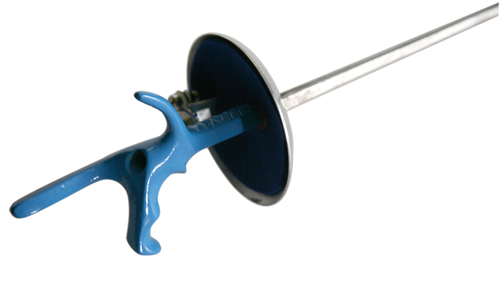
Pistol grip or Belgian grip on a foil
Most sport fencers prefer the Belgian or pistol grip which make the user hold the sword as a pistol which gives a lot more precision but makes the weapon become more of a toy than a weapon for which to practice the duel. Furthermore, in foil points are awarded only for hit to the front of the torso. I could understand if that was in order to count only deadly hits but hits to the head should be discouraged for safety reasons but all of that makes it less like fencing in a historical sense.
The sabre is a cut and slash weapon which has evolved from the military sabre but for sport fencing has half the weight and a very flexible blade which means that quick flicks where the blade flexes around to touch the opponent on the arm often could release points but would have done very little in terms of damage in a war situation. I have heard that the timer for double hits for sabre recently have been raised to 120 miliseconds to discourage flicks but the sport fencers still look to be playing the rules.
The épée is modelled on the training version of a smallsword which was a gentleman duelling weapon and generally carried only as that, it is a very light weapon and possible too light to parry or deflect any battlefield implements such as bayonets and other heavier swords unlike to rapier. èpée also comes with pistol grip in sport fencing.
However Epee is the latest addition to the sport fencing family (in terms of rule revisions) in the great irony that the sport fencers wanted to get back to a more accurate historical form of fencing. One of the rules they took out in order to allow this is the “right of way” (which is still in effect for the other two disciplines). Normally in sport fencing if attacked you must either parry or avoid getting hit before you can hit back and be awarded points. Right of way I feel makes the fencers focus a lot more on the attack and less on the defence. It feels like if they have started their attack the opponent cannot score without making a counter or that you miss (which you really should not). This makes the sport very aggressive to the point of suicidal had it been fought with sharp weapons. By removing right of way the fencing committee hoped that epee would begin to look for like historical fencing and reintroduce more parries. Furthermore the use of full body as target in epee also tend to slow the game down and make it more tactical.
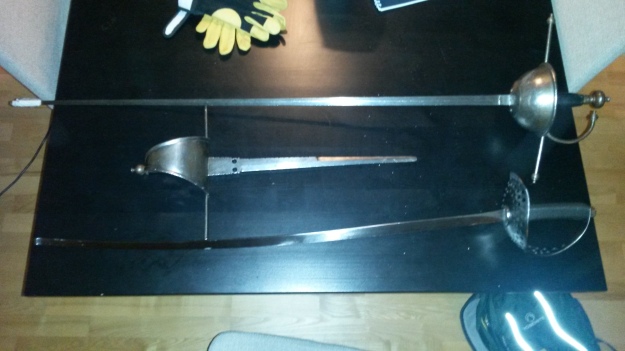
A selection of HEMA weapons, top rapier and parrying dagger, bottom sabre. Most people get surprised by the weight. While heavier than sports fencing most weapons wielded in one hand are in the range of 600 to 1200 g (with execptions) to make them wieldly without being too tiresome for hours of battle
In HEMA many more weapons and combinations are used and also allow for some experimentation as it does not follow rigid rules for normal sparring but of course still need it for tournaments. But what would happen if a basket hilted broad sword faced a rapier (both weapons were used in the same period)? Some of these questions can to some extent be experimented with using HEMA and that is something I really like about it. The return to historical roots and enjoying a sporty approach rather than competing and this ending up playing the rules rather than the game.
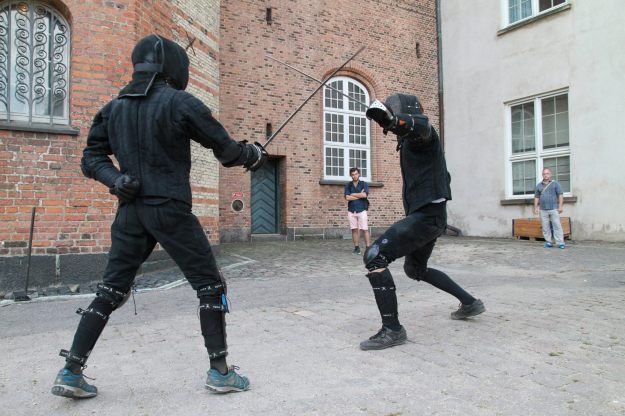
A HEMA military sabre display recently performed and the Armoury Museum in Copenhagen
If historical fencing has peaked your interest either look for HEMA online or see http://www.khfk.dk/ if you are near Copenhagen or perhaps find the CphHistFencingClub on Youtube for cool videos of the latest tournament supported by Copenhagen Historical Fencing Club.